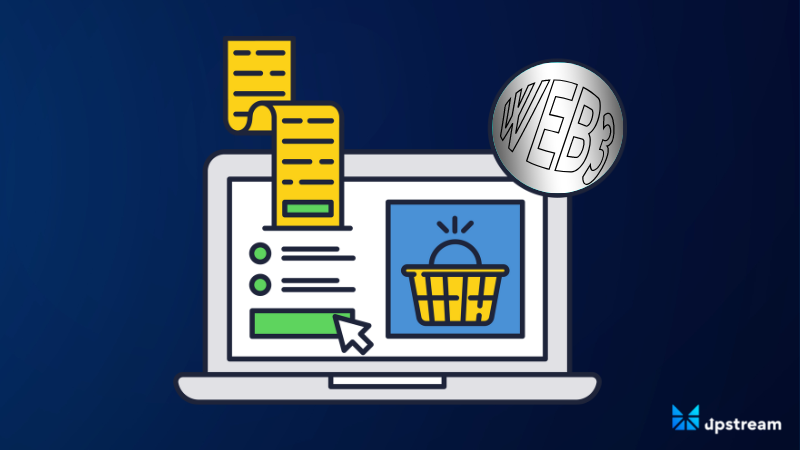Privacy, anonymity, data control; how online transactions be affected by the move from Web2 to Web3

By Fernanda De La Torre
We’ve seen the evolution of the internet from Web1, a “read-only” Web, to Web2, nicknamed the social web where users can interact with the content, and now we’re on our way to Web3. Web3 refers to the internet’s next generation, a more decentralized environment that aims to return power and control from Big Tech to the individual.
Web3 is already beginning to impact how we transact online socially and economically.
With Web3 comes the future of online payments using blockchain-powered wallets for purchases.
Web2 vs Web3 payments
Currently with Web2 payments, consumers are forced to link payments to their personal identity via name, email, and phone number. For instance, all purchases on eBay or Amazon require the customer to input or confirm their personal information for the transaction to be completed.
On Web3, individuals will be known to the internet world via an anonymous blockchain wallet with the option to share or keep information private. This online persona can be decorated with social badges like digital collectibles (NFTs) and other digital assets.
Benefits
- Online identity is not linked to personal identity. This is beneficial for all parties. Using Web3, users can purchase goods and services without disclosing their personal identities. It becomes up to the individual whether they’d like to provide more data, link their purchases, or receive marketing. Common methodology in a Web3 space would be the consumers getting paid by vendors to be marketed to. On the vendor side, companies are still tracking and facilitating user journeys without invading privacy. Further, they remove GDPR exposure because they aren’t harvesting personally identifiable data. There have been countless data hacks that have put vendors in brand jeopardy. Consider Equifax’s data breach, which affected over 145 million customers. The hackers obtained Social Security numbers as well as other personal information that could be used to commit identity theft, such as birthdays, addresses, and driver’s license numbers.¹
- Instant settlement, proof of purchase, and no chargebacks. Web3 platforms that leverage blockchain payments like Upstream offer real-time trades and settlements. On Upstream users can securely buy and settle payments. All transactions are biometrically protected and cryptographically signed and recorded on the app and the blockchain. No merchant enjoys dealing with chargebacks whereas transactions using crypto wallets like Upstream aren’t subject to them. With smart contracts, funds are instantly settled once a transaction is confirmed on the blockchain. And, once a transaction is complete, there is no way to reverse it. Recording it on the blockchain also creates immutable proof of purchase.
- NFTs enhance the Web3 community and enable digital ownership. NFTs have the power to enhance users’ online experience by providing proof of purchase collectibles. Upstream is working with brands across sports, media, and entertainment to help sales and purchases of NFTs as merchandise, and to transcend beyond the initial consumer or fan touchpoint into the metaverse and beyond.
How close are we to Web3 checkouts
We’re here. Upstream offers a full Web3 checkout experience for users while keeping the process user-friendly. On Upstream, your identity is your Ethereum wallet.
The challenge for incoming Web3 Apps working to replace their Web2 counterparts is to make the user journey as frictionless as Web2 platforms to drive adoption. This way the added benefits of security, data ownership, and transparency will outweigh the old familiar web. For example, Upstream keeps most blockchain functionality under the hood to remove friction points. Features such as in-app wallet creation; the ability to fund wallets with digital currency, credit cards, PayPal, or traditional bank payments; and streamlined trading tools create a more welcoming onramp for users unfamiliar with Web3. Upstream’s web3-checkout includes Upstream API’s for sales/payments/website integration to support vendors.
Upstream takes it one step further with NFTs as proof-of-purchase and user engagement. NFTs offer a familiar link from the world of blockchain and Web 3 to Web2. They work to bring the concept of digital ownership to the web and offer a new way for users to engage with companies, art, experiences, and one another. Creators now have the possibility of developing and maintaining ownership of innovative digital content to help grow their personal and professional brands.
Other leading platforms such as Shopify are also utilizing NFTs to better their user experience and boost engagement. Shopify has recently introduced their Tokengated Commerce initiative which allows brands to connect with their fans and drive sales by giving token holders exclusive access to merch, experiences, and more.²
Concluding thoughts
Web3 is changing the way we complete online transactions by providing a safer, more secure process. Users’ identities can be protected behind their Ethereum wallets with Upstream’s Web3 market, and transactions can be executed conveniently and cryptographically securely using face ID. By providing a user-friendly experience, Upstream aims to keep revolutionizing the transition of online transactions into the Web3 space to drive the mass adoption of blockchain technologies.
Interested parties can learn more at https://upstream.exchange/ or reach the team at hello@upstream.exchange.
Disclaimers
*NFTs received have no economic value, royalties, equity ownership, or dividends. NFTs are for utility, collection, and display only.
*U.S. investors are not permitted to trade in upstream listed securities. U.S. and Canadian citizens will only be able to trade in security they currently own that has been listed on Upstream for liquidation only.
*Funding using bank payments. For bank payments, complete KYC and initiate a wire or transfer from your bank or financial institution using the details provided via email after your KYC is approved. If you haven’t already completed KYC identity verification or didn’t select ‘Bank’ as the ‘Deposit From’ option when you completed the KYC identity verification process initially, please go through KYC again selecting this payment method. Complete the KYC identify verification process by tapping Me>KYC
Upstream is a MERJ Exchange market. MERJ Exchange is a licensed Securities Exchange, an affiliate of the World Federation of Exchanges, and a full member of ANNA. MERJ supports global issuers of traditional and digital securities through the entire asset life cycle from issuance to trading, clearing, settlement, and registry. It operates a fair and transparent marketplace in line with international best practices and principles of operations of financial markets. Upstream does not endorse or recommend any public or private securities bought or sold on its app. Upstream does not offer investment advice or recommendations of any kind. All brokerage services offered by Upstream are intended for self-directed clients who make their own investment decisions without aid or assistance from Upstream. All customers are subject to the rules and regulations of their jurisdiction. By accessing the site or app, you agreed to be bound by its terms of use and privacy policy. Company and security listings on Upstream are only suitable for investors who are familiar with and willing to accept the high risk associated with speculative investments, often in early and development stage companies. There can be no assurance the valuation of any particular company’s securities is accurate or in agreement with the market or industry comparative valuations. Investors must be able to afford market volatility and afford the loss of their investment. Companies listed on Upstream are subject to significant ongoing corporate obligations including, but not limited to disclosure, filings, and notification requirements, as well as compliance with applicable quantitative and qualitative listing standards.

